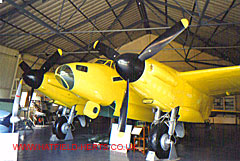 Aviation
– Aircraft
Aviation
– Aircraft
This is section contains many of the aircraft with Hatfield connections. Most are de Havilland Aircraft Company designs. DH design numbers were still used even after the company was absorbed by Hawker Siddeley, and later by British Aerospace. Many famous aircraft made their maiden flights from Hatfield.
Maiden flights from Hatfield
Please note: while researching these dates it became clear that there were a number of cases where the first flight date cited in some sources was given as the date the aircraft made its taxiing trials in others.
DH.87 Hornet Moth – 9 May 1934 (appropriately, the first maiden flight at Hatfield was made with Geoffrey de Havilland at the controls)
DH.88 Comet Racer – 8 September 1934
DH.89 Dragon Rapide – 17 April 1934
DH.82B Queen Bee – 5 January 1935 (pilotless, radio-controlled target drone version of the DH.82 Tiger Moth)
DH.90 Dragonfly – 12 August 1935
DH.91 Albatross – 20 May 1937
DH.92 Dolphin – 9 September 1936
DH.93 Don – 18 June 1937
DH.94 Moth Minor – 22 June 1937
DH.95 Flamingo – 28 December 1938
DH.98 Mosquito – 25 November 1940
Please note: the actual prototype aircraft W4050 (pictured above) can be seen at the de Havilland Aircraft Heritage Centre (originally the Mosquito Aircraft Museum) at London Colney.
DH.100 Vampire – 29 September 1943
DH.103 Hornet – 28 July 1944
DH.104 Dove – 25 January 1945
DH.106 Comet I – 27 July 1949 - world's first commercial jet airliner
DH.110 Sea Vixen – 26 September 1951
DH.112 Venom – 2 September 1949
DH.113 Vampire Night Fighter Mk.10 – 28 August 1949
DH.114 Heron – 10 May 1950
DH Comet II – 27 August 1953
Sud-Est SE.210 Caravelle – the prototype (F-WHHH) first flew on 27 May 1955 at Tolouse, France. The French design was the world's first passenger jet to feature tail-mounted engines. The first two prototypes used DH.106 Comet cockpits and nose assemblies made in Hatfield (later versions used licence-built ones) for the front of the planes, which were powered by Rolls Royce Avon jet engines. This successful Anglo-French aviation cooperation probably helped with later projects between the two countries, like the Concorde, Jaguar and Airbus.
DH Comet IV – 27 April 1958
DH 121 Trident – 9 January 1962 (DH named dropped in 1963, afterwards designated as the HS.121)
HS 125 Executive Jet – 13 August 1962 (components made at Chester)
BAe146 Whisper Jet – 3 September 1981
BAe146-300 – 1 May 1987
Also built and flown at Hatfield were two aircraft designed by the de Havilland Aeronautical Technical School (the forerunner to today's University of Hertfordshire):
TK 2 – 16 August 1935
TK 4 – July 1937
Aircraft production at Hatfield began with the DH.89 Dragon Rapide (the DH.88 Comet Racer had been designed and produced at Stag Lane with final assembly at Hatfield). Once the move to Hatfield was completed successful earlier designs like the DH.82 Tiger Moth were also produced here. From the DH.89 onward de Havilland aircraft (with the notable exception of the DH.98 Mosquito – when mainly Hatfield-based staff were temporarily housed at Salisbury Hall, London Colney – were designed at Hatfield.
The wings for the first Airbus were designed at Hatfield.
Back to: Hatfield claims to fame